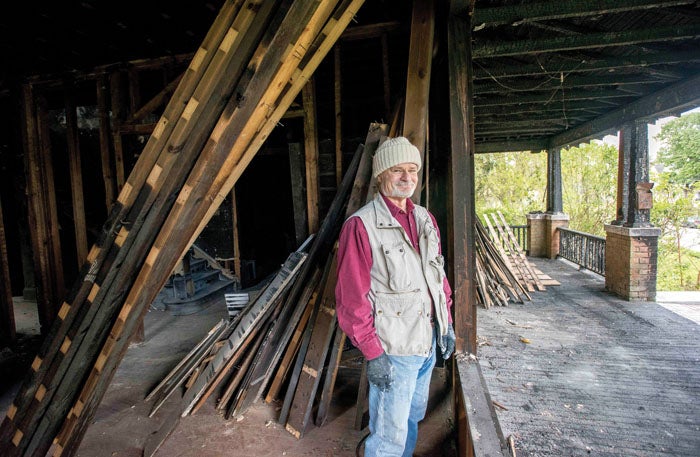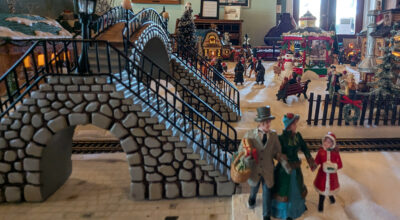Volunteer Week: For Historic Salisbury Foundation, Black and his brigade are always at the ready
Published 12:00 am Tuesday, April 17, 2018

- Doug Black, a longtime volunteer for Historic Salisbury Foundation, has been recently working with Steve Cobb and others at the burned McCubbins House on North Main Street. Jon C. Lakey/Salisbury Post
SALISBURY — For Doug Black, this is what he considers slowing down.
Monday morning, the longtime volunteer for Historic Salisbury Foundation was working in an upstairs bedroom of the McCubbins House at 1013 N. Main St. priming window sashes that are taken out, repaired, refurbished and put back in place.
It’s just part of the stabilization process Black, Steve Cobb and other volunteers tackle with every challenging house the foundation takes on.
With the windows alone, they strip, scrape, sand, prime, rebuild, replace glass, glaze, make allowances for tin weather-stripping and fix the sash cords, weights and hardware.
The work takes an average of 16 to 20 hours per window — and this old house has 27 windows.
Black, 72, works four hours every Monday, Tuesday and Thursday morning. He quietly has turned over leadership of his famous “Col. Black’s Brigade” to Cobb and acknowledges that a serious health issue has forced him to use his afternoons and weekends for rest.
Cobb is reluctant to say he’s the new captain of this outfit.
“Those are big shoes to fill,” Cobb said.
Black and Cobb laugh, describing what their first reactions often are when they walk into a place the foundation wants to preserve, stabilize and put back on the open market for a loving owner to restore.
“It’s scream and run the other way,” said Black, a retired Marine Corps colonel, “and what the hell are we doing here?”
Black’s Brigade through the years has included folks such as Don Conner, Rich Dietrich, Gene Krueger, Neil Beuher, Mary Walker, Barb Sorrell, Jim Carli, Ray Barber — and more.
“It really took off on Blackmer,” Black said, recalling how the foundation’s volunteer brigade descended on the 1820 Fulton-Mock-Blackmer House, tackling 30 years of overgrowth and neglect after a devastating fire in 1984.
Black’s Brigade also has done the dirty work on other houses worth saving on North Main Street, Bringle Ferry Road, and East Innes Street and in West End. Many of the structures were exposed to the elements and being used by the homeless.
Black donned a body suit once in the early cleaning stages of the Bernhardt House, which is now restored and occupied on East Innes.
Back in his early days helping the foundation, Black took on Grimes Mills’ decades worth of dead birds, bird droppings and dust. When the historic mill was lost later in a fire, Black led the team, which included Cobb, that salvaged and cleaned some 31,000 bricks.
Black describes the work as fulfilling and has loved the camaraderie of Black’s Brigade, especially on those days when he dreaded thinking about the tough chores ahead.
“If you’re not working alone,” he says, “it is much better.”
But Black’s Brigade only scratches the surface of how Black has worked for the foundation since 2001, when he and his wife, Leslie, moved here permanently. They started out as Hall House museum docents, but by last Thursday night’s annual meeting, the HSF board had named Doug a “trustee emeritus.”
Black also received the foundation’s highest honor, the Clement Cup, in 2011 and its Volunteer of the Year recognition in 2012. In fact, it is now known as the Doug Black Volunteer of the Year Award.
In the past, Black has served as HSF’s board president.
Since 1972, volunteers have been the backbone of Historic Salisbury Foundation.
“Out of all of them,” HSF President Susan Sides said last Thursday, “one of them rises to the top.”
She was referring to Black, who before his recent health concerns was working on some kind of HSF project at least five days a week.
“And remember,” Sides said, “he is a volunteer.”
Black has been part of the renovations of the slave kitchen on the rear property line of the Hall House. He has labored from roof to basement and in the tower of Salisbury Station.
Black headed the project to build a replica well house on the Rowan Public Library site — a place where future President Andrew Jackson likely drank during his young adult days in Salisbury.
With Rowan Museum, Black and HSF helped start the 13-week Rowan County History Course, which is still going.
In Fulton Heights, where he lives, Black put together a comprehensive history of the neighborhood for its 100th anniversary in 2006 and also was the man behind establishing its neighborhood watch program.
Black was the person the foundation knew it could count on when it entered a partnership with Livingstone College to address six houses in the West End. Black and Cobb have led the foundation’s brigade in stabilizing the structures before the college comes in to complete the restorations.
The HSF-Livingstone partnership is preparing to take on the third of those six homes.
Sides said it was always important to Black, after a large storm passed through the area, to check out the foundation-owned landmarks, such as the Hall House and Salisbury Station. He would look for any hints of damage.
Better to crawl into the attic or tower then and look for leaks or cracks, Black says, than have to take on a bigger problem later. He even made up his own rhyme for it:
You got to look for trouble every day
and catch it while it’s small.
If you wait for trouble to find you,
it won’t be small at all.
Sides was driving home one night and passed the Hall House on South Jackson Street. She looked at the side of the structure and saw Black on a tall ladder, painting by himself.
“I’m calling Leslie,” Sides shouted at him.
“He just ignored me and kept on painting,” Sides said.
Before his retirement after 30 years with the Marine Corps, Black worked at the Pentagon. He then took a job with Sprint but was a layoff casualty after the terrorist attacks in 2001 hurt the company’s bottom line.
Doug and Leslie Black had actually visited Salisbury around 1995-96 during one of the day trips they took while visiting their youngest son, John, in Greensboro. They ate sandwiches and ice cream at Spanky’s and told themselves Salisbury might be a nice retirement spot someday.
It was. Three of their five sons and their families live in North Carolina, which also means five of their nine grandchildren are close by.
It was a visit to the Hall House for a weekend tour that led them to then-Executive Director Diane Dillon and their start as Hall House docents.
“Then it sucks you in,” Black said of what led to his and Leslie’s total involvement in HSF.
Leslie has volunteered for 16 years at the Hall House, along with tending to its herb garden for 11 years.
“She has been my editor so that all the documents I wrote in support of HSF were presentable,” Doug said. “Plus, she has been the editor and publisher of the Rowan County Genealogy Quarterly Journal for several years. And there is more.”
Downstairs at the McCubbins House, the fire left rooms even more charred and toasted. Black’s Brigade is taking everything out to the studs, scraping off the black and bringing the wood back to life. Already, the volunteers have filled enormous metal trash bins with demolition debris and household items left behind.
“The whole place needs a mama for about a year or two,” Black said.
Gary Curlee will be asked to remanufacture six new 30-by-28-inch windows downstairs because the fire and damage caused in fighting the fire make them impossible to refurbish.
Black said he recently inspected his own house in Fulton Heights and found that 11 of his 28 windows need repairs.
It’s the old story, Cobb tells him, that the shoemaker’s children are the ones who have no shoes. Like Black, he’s too busy looking after someone else.
Contact Mark Wineka at 704-797-4263.





